Which are the frequency bands for NB-IoT, LTE Cat 1, Cat M1, EC-GSM IoT, Zigbee, Google Thread, LoRa, SigFox, Bluetooth LE and Wirepas protocols? The global IoT spectrum is confusing with countless licensed and unlicensed frequency bands and regional fragments. This article provides you with a detailed description of the frequency bands for the ten most popular IoT protocols worldwide!
You can download the complete Guide for IoT Frequency Bands in PDF format on the bottom of this page.

Using IoT data in Smart Buildings
What kind of data can you get and how is all this data used?
IoT Spectrum Overview
IoT devices usually require a low data throughput for sending short, periodic data bursts. They can be though located in places with poor signal reception without a line of sight connection to the nearest base station. The constrained IoT device form-factors limit transmission power and battery size.
From this perspective, it is logical that most IoT protocols are in the low band frequencies, which provide optimal radio characteristics for most IoT applications.
ISM Band Frequency Range
The Industrial, Scientific and Medical (ISM) frequency bands are reserved internationally for industrial, scientific and medical purposes. However, many household appliances and gadgets operate on ISM frequency bands, and now IoT devices are rapidly occupying this radio frequency range.
Low bands provide the best RF propagation capabilities when obstructions such as walls, trees, and leaves are in the line of sight. Lower frequencies support the constrained IoT device form-factors – a transceiver at a low band consumes less energy than a transceiver at a higher band for the same performance vs. transmit power.
A disadvantage of lower frequencies is that the usable frequency bands are usually narrow, and the unlicensed ISM bands are duty-cycle-limited, and therefore only allow for low data throughput. However, that’s all right for most IoT applications!
2.4 GHz ISM Band
The 2.4 GHz, the ISM band, is used for Bluetooth, WiFi, cordless phone, printer, keyboard, mouse, garage door opener, and countless other wireless gadgets. It is the most widely used frequency band and often overcrowded. The 2.4 GHz frequency band offers a low-range, high bandwidth IoT channel.
ISM frequency bands typically do not require a license to operate, and therefore they are crowded and noisy and require robust RF mechanisms to tolerate interference.
Cellular IoT Frequency Bands
The cellular IoT protocols are fragmented across tens, if not hundreds of frequency bands. Most of them are in the lower spectrum bands. For example, 60% of the LTE Cat M1 and NB-IoT frequency bands are in the sub-GHz range, and only 30% are above 1.8 GHz. This frequency profile reflects the typical requirements IoT applications have.
Here is a run-down of the frequency bands including the regional frequency allocations for the ten most popular IoT communication protocols.
NB-IoT frequency bands
There are 26 NB-IoT frequency bands in total, more than 60% of them are in the sub-GHz frequency range, and less than 30% are above the 1800 MHz.
Four NB-IoT frequency bands are allocated for global use, and there are five regional frequency allocations. NB-IoT spectrum does not include Time Division Duplex (TDD) bands.
NB-IoT is positioned as a highly robust and power-efficient protocol with a low-bandwidth, which is reflected by the low band-heavy spectrum profile.
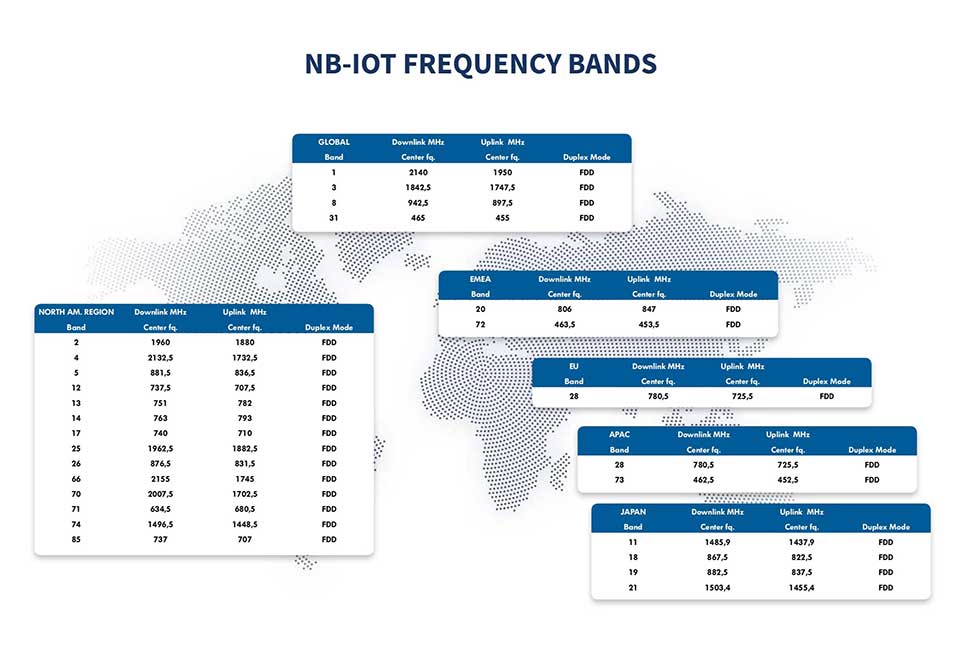
Download the complete table of NB-IoT frequency bands in the end of this article.
LTE Cat M1 Frequency Bands
LTE Cat M1 provides more bandwidth compared to NB-IoT, and the LTE Cat M1 spectrum also contains more bands in the higher range. Over 20% of the 29 frequency bands allocated for Cat M1 are in the above 2 GHz range, compared to 15% in NB-IoT.
Five Cat M1 frequency bands are allocated for global use. Six regional frequency allocations include also a few TDD bands in China.
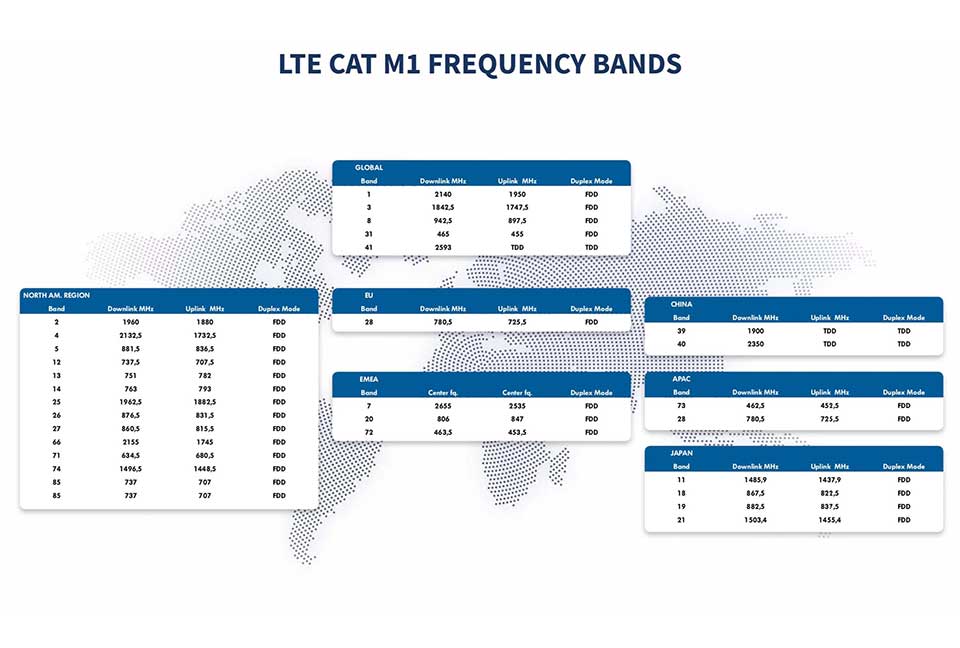
LTE Cat 1 Frequency Bands
LTE Cat 1 spectrum is nearly evenly split between sub-GHz bands (55%), and bands above the 1.8 GHz (45%). Five LTE Cat 1 frequency bands are allocated for global use, and there are six regional frequency allocations.
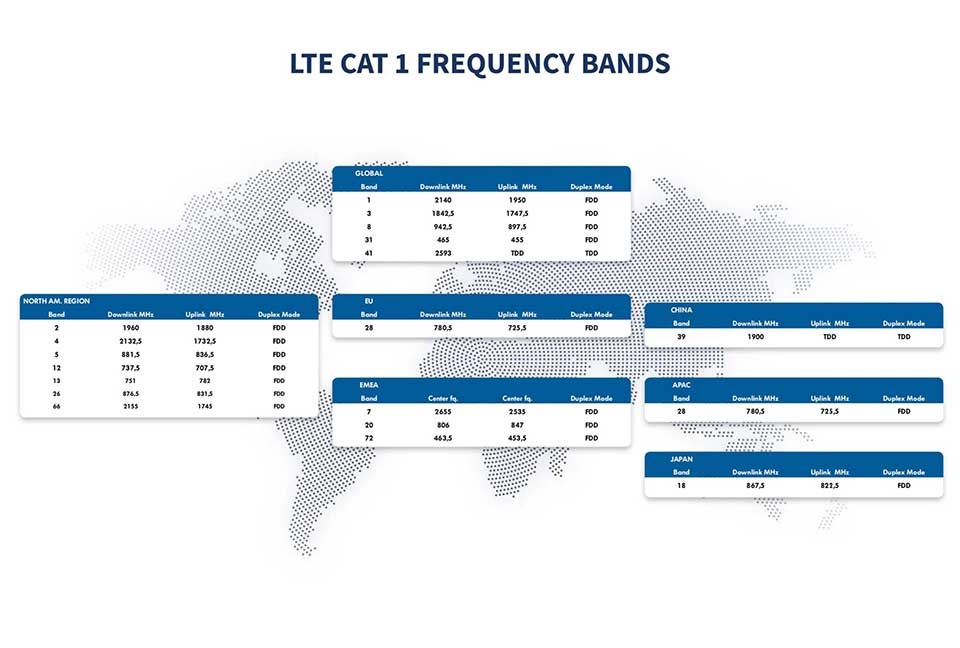
EC-GSM IoT Frequency
Extended Coverage GSM IoT protocol spectrum is allocated across 13 GSM/EDGE frequency bands ranging from 395 MHz to 1960 MHz. In addition to the globally allocated bands, there are three regional frequency allocations for EC-GSM IoT.
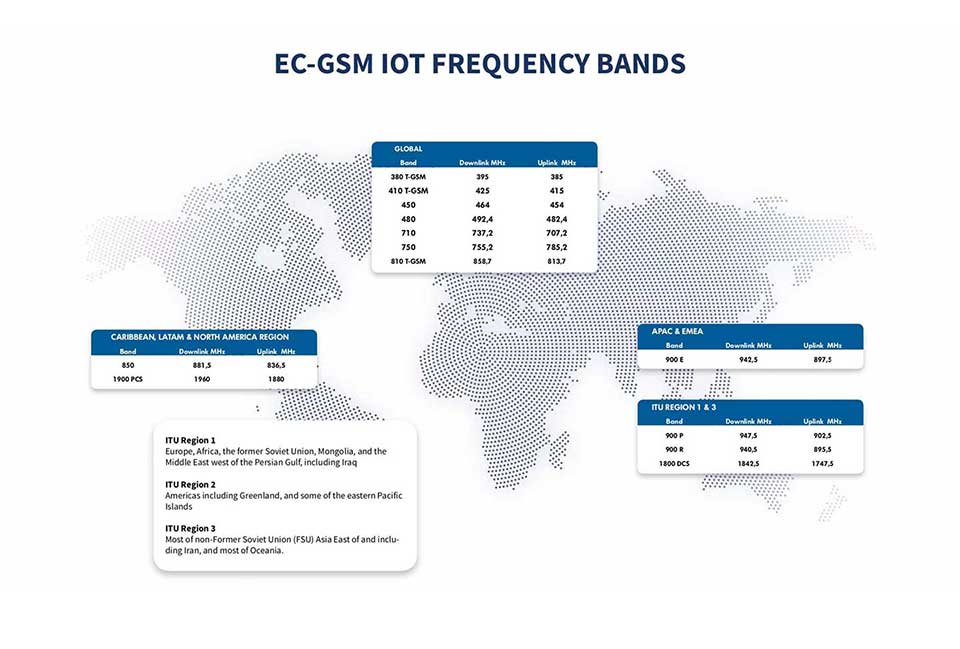
LoRA Frequency Bands
The LoRa protocol operates on unlicensed sub-GHz ISM frequency bands, of which only part of the regions have been fully specified so far (Europe, the North America region). LoRa frequency band specifications in China, Korea, Japan, India and other regions are yet to be finalized.
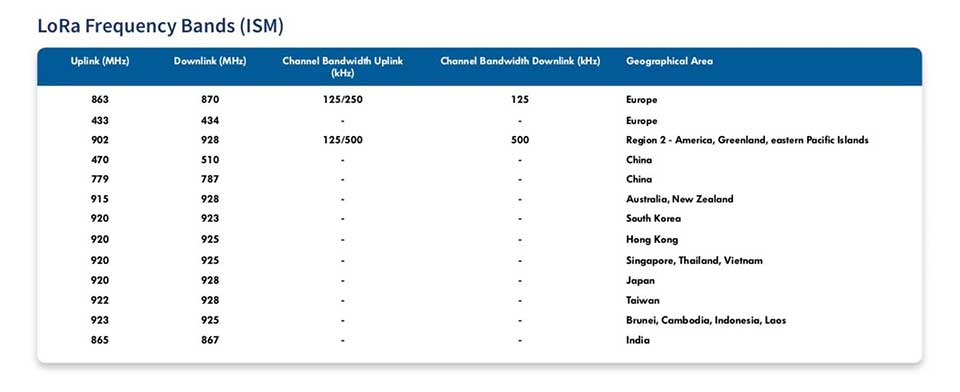
Bluetooth Frequency Bands
Bluetooth Low Energy frequency is the global, unlicensed Industrial, Scientific, and Medical (ISM) 2.4 GHz short-range frequency band. It is limited between 2400 and 2500 MHz, which includes guard bands of 2 MHz at the low end and 3.5 MHz wide at the high end. The BLE frequency band is divided into 79 channels each with a bandwidth of 1 MHz.

Zigbee Frequency
Zigbee frequency is based on the IEEE standard 802.15.4 wireless protocol. It is operating on one of three unlicensed ISM frequency bands:
- The global Zigbee frequency channel is 2450 MHz
- Zigbee channel frequency in Europe is 868 MHz
- Zigbee United States frequency is 915 MHz

Wirepas Frequency
Wirepas Mesh protocol uses Bluetooth Low Energy radio protocol, so it operates on the global, unlicensed ISM 2.4 GHz frequency band. It is limited between 2400 and 2500 MHz, which includes guard bands of 2 MHz at the low end and 3.5 MHz wide at the high end. The BLE frequency band is divided into 40 channels each with a bandwidth of 1 MHz.

Sigfox Frequency Band
Sigfox operates in the unlicensed ISM frequency bands. Different bands are available for Sigfox networks in different in regions. There are currently six geographical regions, or Radio Configurations (RC) for Sigfox: RC1 – RC6. This situation can change as new networks and countries are added.
Each region has a different set of parameters, which clearly dimension the device hardware implementation in terms of frequency range, maximum radiated power, and radio front end other specifics.
The table below summarizes the frequency bands in which Sigfox operates in the different regions.

Thread Protocol Frequency
Google wireless Thread frequency range is based on the IEEE standard 802.15.4 wireless protocol. It is operating on one of three unlicensed ISM frequency bands:
- Thread protocol frequency in Europe is 868 MHz
- Thread protocol frequency is 915 MHz in North America
- The global Google Thread protocol frequency range is 2450 MHz

Download Haltian’s Global Guide for IoT Frequency Bands

Common technologies in IoT devices
Technology is key to get right when creating your IoT solution. The primary objective for your solution should be creating value, read how different types of sensors help you achieve your goals!
Learn more